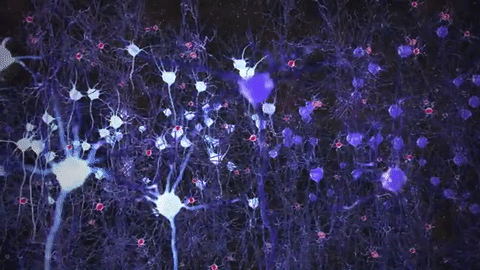
22 Nov The Art in Artificial Intelligence
Simulating the intuitive feel of natural conversation using Intelligent Flow Propogation.
If you’re like me, you probably use language to communicate. I don’t blame you — it’s pretty effective:
Imagine the smell of newly popped popcorn tumbling out of its bag, the crackle of straggling kernels still faintly audible. Let the *hiss* of escaping carbon dioxide fill your ears as you pop the tab off of an icy soda can, its aluminum frame glistening with pregnant drops of condensation.
You’ll immediately notice the absurd amount of imagery that is smuggled in with just a few inches of admittedly mediocre prose. What you won’t have noticed, is that these last sentences conducted an entire symphony of visceral reactions in your anatomy.
Your pupils dilated.
Your pulse elevated.
Also activated was the neuron in your brain that handles all popcorn-related inquiries!

Source: www.giphy.com
With the sheer variety of biological architecture mobilized for linguistic processing, it’s hardly surprising then, that humans do language so well. We have an intuitive grasp of even the most complex concepts and relationships.
Language is, by no stretch of the imagination, one of the most defining characteristics of humanity.
Beyond Human
Unfortunately for computers, Natural Language Understanding (NLU) is considered a strictly AI-complete problem — until we endow our technology with human-level (and beyond) intelligence, fully conversational virtual assistants are to remain the stuff of science-fiction.
Don’t lose hope though! In the mean time, we’ve got this:

Fios Verizon Service Bot
Those of you with a keen eye will notice that “Fios” has some work to do.
Luckily for us, the global research community is ferociously active in this area of Artificial Intelligence. Quality of content notwithstanding, a quick Google Scholar search for NLU-related scientific papers will tell you that over 38,000 articles have been published since January of 2017 alone!
And yet, we all know that even the most cutting-edge machine learning (ML) algorithms have had less than spectacular success during field testing:
 Source: http://www.businessinsider.com
Source: http://www.businessinsider.com
I’m pretty sure most of that isn’t even true, Tay.
At this point, it might be wise of us to ask: Is there no middle ground between the agonizingly error-prone service bots that litter the internet, and algorithm fueled PR nightmares?
As in every realm of human understanding, there exists somewhat of a no-man’s-land between academia and industry, with safe passage being granted only to those with the most creativity.
Safe Passage
Intelligent Flow Propagation is both a technical term, and a design aesthetic that interleaves the cold-efficiency of algorithmic approaches with the imaginative versatility of the human language. It’s also ripe for acronymization.
Yes, that’s a word. Look it up.
Gingerly side-step all of that techno-marketing babble and let’s “parse” this definition. Pun very much intended.

Source: www.giphy.com
First, the basics: In the common parlance of NLP, intents are the parts of a statement that indicate, well… your intentions, and entities are nouns or objects related to that intention within the same domain of knowledge.
Stated differently, if you told Alexa to play your favorite Beyonce song on Spotify, your intent is to “play a song” with the entity, “Single Ladies” in the domain of “music”.

Source: Avaamo’s Conversational AI Platform
With this terminology in our rear-view mirrors, we can now drive towards a more concrete description of IFP (there’s that acronym!):
Within a general domain, classify statements based on a few intents, then dynamically direct the conversation according to specific entities.
By limiting the scope of the conversation to a single domain and a set of limited intents, we can protect against a Level “Tay” Catastrophe Event. On the other hand, giving the artificial intelligence some freedom to direct the interaction will hopefully lead to a “Fios” bot that doesn’t just sit there and eat glue all day.
Making it Happen
So how do we actually do this?
Since the minute details of parsing text data and tuning deep neural networks are not crucial for our purposes, we’d ideally like to use a system that handles most of this algorithmic heavy lifting internally.
Using a platform like Avaamo’s, we can offload AI processing and focus on IFP implementation by first building a comprehensive domain with intents and entities:

Healthcare Entities for a Diagnostic Virtual Assistant
Then, after developing the general “flow” of a conversation…
 A Conversation Flow for a Diagnostic Virtual Assistant
A Conversation Flow for a Diagnostic Virtual Assistant
…we instruct our natural language agent to “hop” back and forth according to specific entities.
In this way, even when virtual assistant performance has to be strictly choreographed, our agent can provide adaptive and nuanced responses, within a structured environment:

Healthcare Diagnostic Assistant
Thanks to the combined effort of efficient classification algorithms and a thoughtfully constructed domain, our virtual assistant is able to jump right to the relevant questions.
And it even picked up on conversational subtleties like the gender of the patient. Not too bad!
Final Thoughts
Intelligent Flow Processing is the bubble-wrap that allows us to ship cutting edge NLU to the masses.
By sandboxing our natural language agents within a specific domain, we significantly lower the severity and frequency of conversational blunders. The ability of our agents to then navigate the remaining space with some level of autonomy sets the stage for a truly meaningful interaction.
For a long time yet, humans will retain linguistic superiority over our technological counterparts. That’s because for us, language isn’t about letters, words, or parts of speech. Its about experience and emotion.
Combining our ability to intuitively organize knowledge with that of artificial intelligence to efficiently sort it, allows us to take a step into exciting new territory.
At the very least, it’s a step away from this:

Source: www.thenewdaily.com.au


